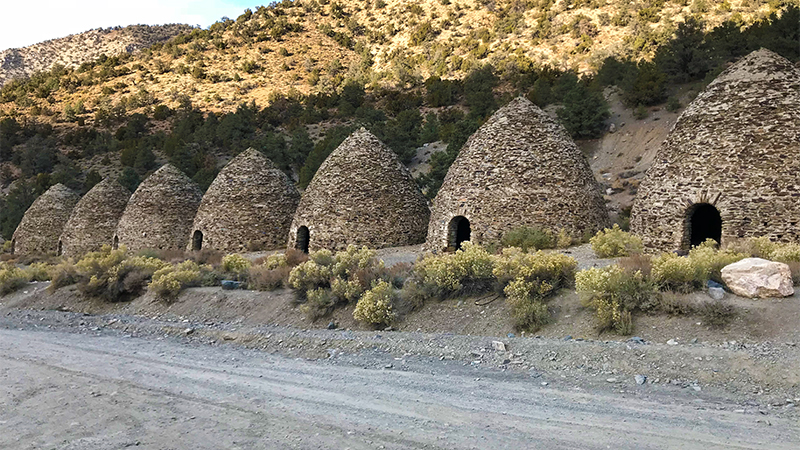
Road tripping in the winter is so much different than road tripping in the summer. In the summer, it stays light until after 9:00 pm and we can explore and hike for hours after dinner, but in the winter, it gets dark by 5:00 pm and you’ve got to call it a day. On this trip, we were done exploring Death Valley by 4:00 pm each day because the sun was already so low that anything we wanted to do would be shaded and dark.
So, after fueling up in Stovepipe Wells, driving out to Father Crowley Vista, hiking out to Darwin Falls, and stopping in Panamint Springs, the Wildrose Charcoal Kilns were our last activity of the day — especially because they were so far away! The drive from Panamint Springs Resort to the Charcoal Kilns is 33 miles, with the last few miles on a dirt road, so it took over an hour to get there. The drive was long through the desert, but to our surprise we actually saw a wild donkey! Most were eradicated from Death Valley years ago, but a few still remain and we saw one!
Wildrose Charcoal Kilns
The Wildrose Charcoal Kilns consist of ten beehive-shaped, stone and masonry structures that are among the best preserved in the western states. Built in 1876 and completed in 1877, each kiln measures 25 feet high and 30 feet wide, and they still smell of smoke! The kilns burned wood from Pinyon Pines to transform it into charcoal, which was transported over the mountains, where it was used to extract lead and silver from the ore mined in Death Valley.
We reached the Wildrose Charcoal Kilns just before sunset and I think went inside every single one! They were built in a beehive shape to keep the heat focused in the center of the kiln. Now, if you go inside and clap your hands, the sound changes dramatically based on where you stand.
Modock Mines
The Wildrose Charcoal Kilns were built by the Modock Consolidated Mining Company to provide fuel suitable two smelters adjacent to their group of lead and silver mines west of Panamint Valley about 25 miles away. It is believed that the mines were worked intermittently until about 1900, But there is no evidence that the charcoal kilns were used after 1879.
One of the incorporators of the Modock Company was George Hearst, Father of William Randolph Hearst. George Hearst was a mine expert, but the Modock group was not a success, as it only grossed around $3,000,000 over thirty years.
Know Before You Go
- The historic Wildrose Charcoal Kilns are located in upper Wildrose Canyon in the Panamint Mountains on Charcoal Kiln Road in Death Valley National Park, California, 92328.
- From Panamint Springs, follow CA-190, turn right onto Panamint Valley Road, left onto Wildrose Road, right at Emigrant Canyon Road, which becomes Wood Canyon Road, which becomes Charcoal Kiln Road.
- The last two miles of gravel road to the kilns are passable to most vehicles.






